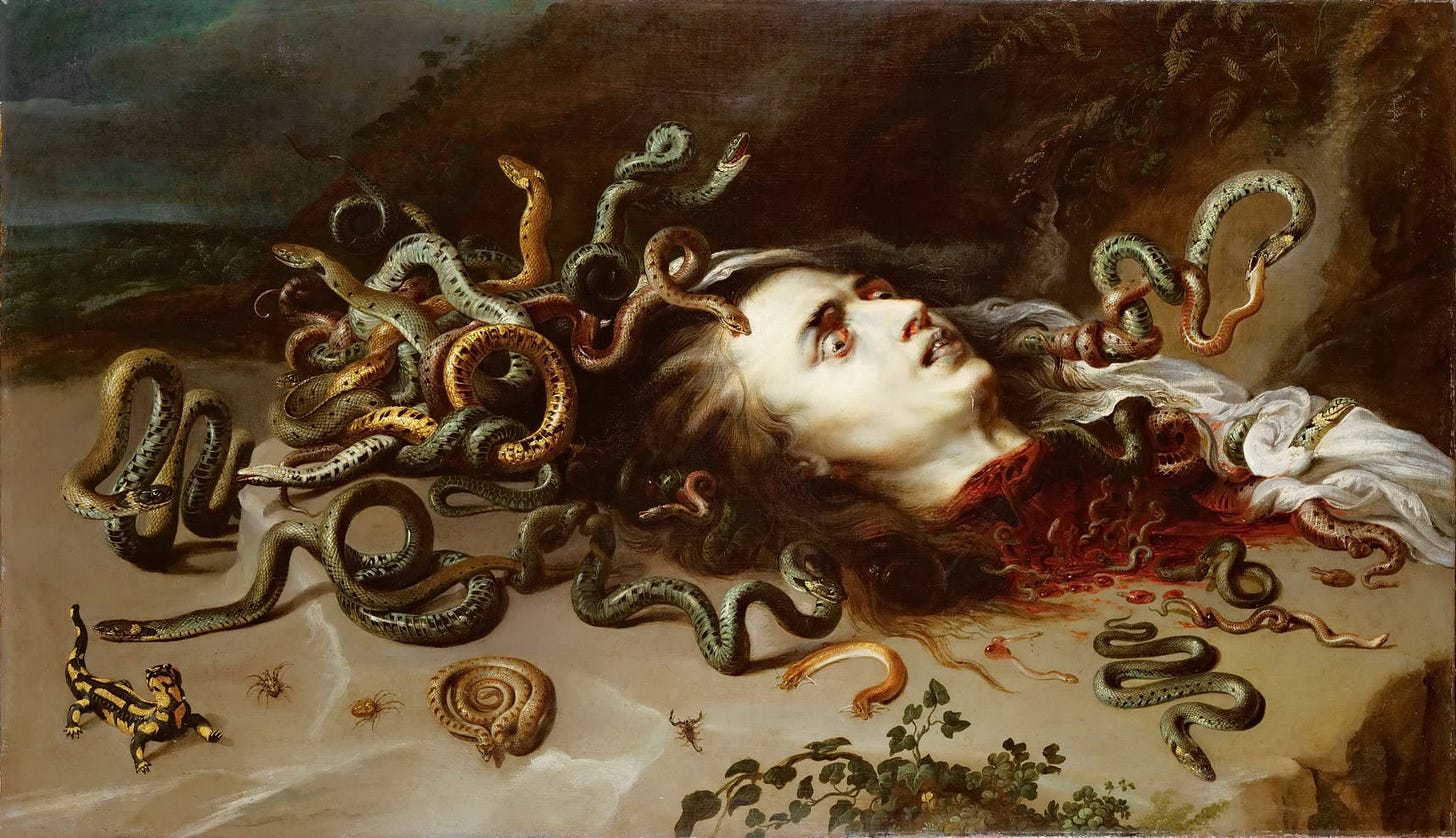Snakes, Sorrow, and Stone: Medusa’s Tale Through Masterpieces. I
Medusa wasn’t always the snake-haired, stone-turning Gorgon we know from the myths. Once, she was a stunning mortal woman with hair that flowed like a river of gold and eyes that could make anyone stop in their tracks. She lived in a world where the gods walked among humans, their whims shaping lives like clay. Medusa was a priestess in Athena’s temple, devoted to the goddess of wisdom, who demanded purity and loyalty from her followers. It was a sacred engagement, one that came with vows of chastity, and Medusa took it seriously, tending to the temple’s flames and offerings with a kind of quiet grace.
Now, here’s where things get messy. Poseidon, the sea god, all brash and untamed, caught sight of Medusa one day. He was smitten, and not in a sweet, write-you-poetry kind of way, more like a god who’s used to getting what he wants, no questions asked. Some stories say he pursued her right there in Athena’s temple, a place that was supposed to be sacred, untouchable. Others whisper that Medusa, despite her vows, couldn’t resist the pull of a god’s attention. Either way, something happened in that temple, whether it was love, coercion, or something in between, we’ll never know the full truth. But it was enough to shatter the peace.
Athena, wasn’t having it. She was furious, not at Poseidon (because gods, you know, they get a pass), but at Medusa. Maybe it was the violation of her sacred space, maybe it was jealousy, or maybe Athena just needed someone to blame. Instead of confronting her uncle Poseidon, she turned her wrath on the mortal. In a flash of divine rage, Athena cursed Medusa. Her golden hair twisted into writhing snakes, her face became so monstrous that a single glance could turn anyone to stone, and her life as a human was over. She was no longer the beautiful priestess but a Gorgon, exiled to a desolate island with her two immortal sisters, Stheno and Euryale, who were born monstrous, unlike her.
Let us explore how artists across time have painted and sculpted Medusa in all her tragic, terrifying glory. It’s an interesting ride through galleries and centuries, filled with emotion and artistry that’ll leave you seeing Medusa in a whole new light.
Caravaggio, a Baroque genius, didn’t just paint Medusa, he made her leap off the canvas, or rather, off a convex wooden shield. This isn’t your typical flat painting; it’s crafted to look like a battle shield, mimicking the myth where Perseus uses a reflective shield to avoid Medusa’s petrifying gaze. Caravaggio used his own face as the model, twisting it into a scream of pure, heart-stopping terror, he makes you feel for Medusa. Sure, she’s the monster of myth, but that expression screams vulnerability, shock, and a touch of betrayal. It was commissioned by Cardinal del Monte for the Medici family, a power move of a gift, and it’s no wonder it’s still a star in the Uffizi.
Peter Paul Rubens’ portrayal can be found stealing the show at the Kunsthistorisches Museum in Vienna, Austria (with a second version in the Moravian Gallery in Brno). Rubens gives us Medusa’s severed head, fresh from Perseus’ sword, lying on a rocky surface like a grim trophy. The real stars are the snakes painted by Snyders with such obsessive detail that they practically slither off the canvas. What’s absolutely fascinating here is how Rubens and Snyders balance horror with humanity, there collaboration is a stroke of genius, Rubens handles the emotional weight, while Snyders’ critters add a layer of uncanny realism, like a snapshot from some mythical crime scene.
Bernini, the Baroque master who could make stone feel alive, gives us a Medusa unlike any other not a severed head like Caravaggio’s, but a living, breathing figure caught in a moment of raw, soul-deep emotion. Her eyes, shimmer with a mix of fear and sorrow, as if she’s just realized the curse Athena slammed her with. Her brows are furrowed, giving her a hauntingly human quality, like a woman trapped in a nightmare she can’t escape. Bernini captures Medusa mid-transformation, not as the monstrous Gorgon but as the woman struggling with her fate. Housed in the Capitoline Museums, this bust is a testament to Bernini’s genius for infusing cold stone with warm emotion, likely a gift for the Barberini family (Bernini’s longtime patrons).
Böcklin paints Medusa as a woman caught in a moment of eternal sorrow. Her lips, faintly blue, are slightly parted, giving her an almost ghostly air, as if she’s fading into her own myth. It’s like Böcklin decided to tame the horror and focus on her soul instead. She’s not here to petrify you; she’s a tragic figure, a woman wronged by the gods, and Böcklin’s brush makes you want to sit with her and listen. Böcklin flips the script on her myth and seems to ask “What if we saw her as human first?”Tucked away in Germanisches Nationalmuseum in Nuremberg, Germany, this Medusa feels like a hidden gem, waiting for you to discover its quiet power.
Von Stuck’s Medusa is no screaming, severed head, she’s alive, staring right at you with wide, hypnotic eyes that feel like they could pierce your soul. The snakes in her hair are a writhing crown, painted with such slinky, sinuous detail that they seem to pulse with life, yet von Stuck cleverly avoids showing their heads, keeping your focus locked on Medusa’s face. This Medusa isn’t just terrifying, she’s magnetic, a combination of beauty and horror that pulls you in, daring you to look closer while warning you of the consequences.
In the concluding article we'll be diving into the epic showdown where Perseus, hunts down our Gorgon queen and well, let’s just say it’s a tale packed with bravery, trickery, and a mirror that changes everything.









i always interpreted Medusa as a rather tragic figure. for her beauty she was raped (in my reading of the myth) and for her ugliness she was killed.
i also like to think Athena "cursed" Medusa to protect her, giving her a chance to defend herself. the figurehead of Medusa was used in many places that housed women in Ancient Greece as a symbol of protection.
sorry for my lack of real grammar and uncoherent sentences, its late and im tired lol. well written article! very interesting.
Funny how the interpretation of a tragic violation 2000 years after it happened. I'd like to see a deep view of medusa on Greek Art or through the time up to meduss tatoo and her reinterpretation as a simbol for women